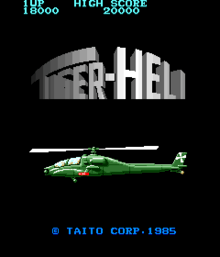Tiger Heli
| Tiger Heli | |
|---|---|
 Title screen | |
| Developer(s) | Toaplan |
| Publisher(s) | Taito (Japan) Acclaim (North America) |
| Distributor(s) | Romstar (North America) |
| Composer(s) | Tatsuya Uemura |
| Platform(s) | Arcade, NES, PlayStation |
| Release date(s) | 1985 |
| Genre(s) | Vertical scrolling shooter |
| Mode(s) | Up to two players, alternating |
| Cabinet | Upright |
| CPU | 2 x Z80 @ 6 MHz M68705 @ 2 MHz |
| Sound | 2 x AY8910 @ 1.5 MHz |
| Display | Raster, vertical orientation, 240x280 resolution |
Tiger Heli (タイガーヘリ) was one of the first games developed by Toaplan (a now defunct Japanese arcade game developer) and published by Taito Corporation in 1985. It is a predecessor to Twin Cobra. The player controls a helicopter named Tiger Heli taking out various enemies along the way. It was published by Acclaim Entertainment in North America, where it sold one million copies.[1]
Gameplay
The game is a vertical scrolling shooter where the player controls a helicopter taking on hordes of enemies which include tanks, battleships, and artillery. It is interesting to note that, besides some airplanes taking off, there are no flying enemies in the entire game. The player's main weapon is an unlimited supply of missiles which travel a max distance of half the screen's height. The player also has two bombs which destroy all objects within a large circular radius. These bombs can be blown off by enemy bullets. The player is killed after only one hit, and is re-spawned to a point approximately one whole vertical screen-length later, thus progressing the player past the obstacle that had killed him, albeit at a high cost. The player is given three lives initially and bonus lives are awarded at 20000 points and every 80000 points thereafter. Flashing crosses scattered throughout each level award players power-ups depending on which color the cross is. A red cross will gives the player one side-firing mini-heli which shoots perpendicular to the player's helicopter. A white cross yields a forward firing mini-heli. It is possible to have a mix and match of side-helis, totaling no more than two. The green cross will award the player with an additional bomb, if the player currently has less than two. Grabbing power-ups when not necessary yields 5000 points.
There are a total of four stages, all of which start and end with a helipad. After completion of the last stage, the game will restart in a more difficult mode starting on stage 2. Most of the game's areas contain unnecessary objects to destroy for bonus points, such as oil drums and houses. This was uncharacteristic for shoot 'em ups at the time.
Ports
Tiger Heli was ported to the NES by Micronics and distributed by Acclaim in the United States and by Pony Inc. in Japan.
Toaplan Shooting Battle 1 for the PlayStation (released by Banpresto) features an emulation of Tiger Heli.
Reception
Computer Gaming World called Tiger-Heli for the NES an excellent port, and concluded that it was "one of the most exciting arcade shoot-'em-ups to turn up".[2]
Sequels
Tiger Heli had two sequels, Twin Cobra and Twin Cobra II, whose Japanese titles indicated that they were sequels of Tiger Heli. In addition, Tiger Heli (called Tiger in Japan) made an appearance in Let's! TV play classic series in Slap Fight Tiger as an alternative to the default aircraft Leopard.
See also
- Flying Shark / Sky Shark
References
- ↑ Kent, Steve L. (2001). The ultimate history of video games: from Pong to Pokémon and beyond : the story behind the craze that touched our lives and changed the world. Prima. p. 310. ISBN 0761536434. "Acclaim exceeded 200,000 in sales of its next game, 3D World Runner, and more than one million copies of Tiger Heli—a game that Taito released in Japan but decided against releasing in the United States."
- ↑ Worley, Joyce; Katz, Arnie; Kunkel, Bill (September 1988). "Video Gaming World". Computer Gaming World. p. 50.
External links
- Tiger Heli at the Killer List of Videogames
- Tiger Heli guide at StrategyWiki
- TG16 information at The PC Engine Software Bible (old version via Archive.org)
- TG16 information at The PC Engine Software Bible (current version)